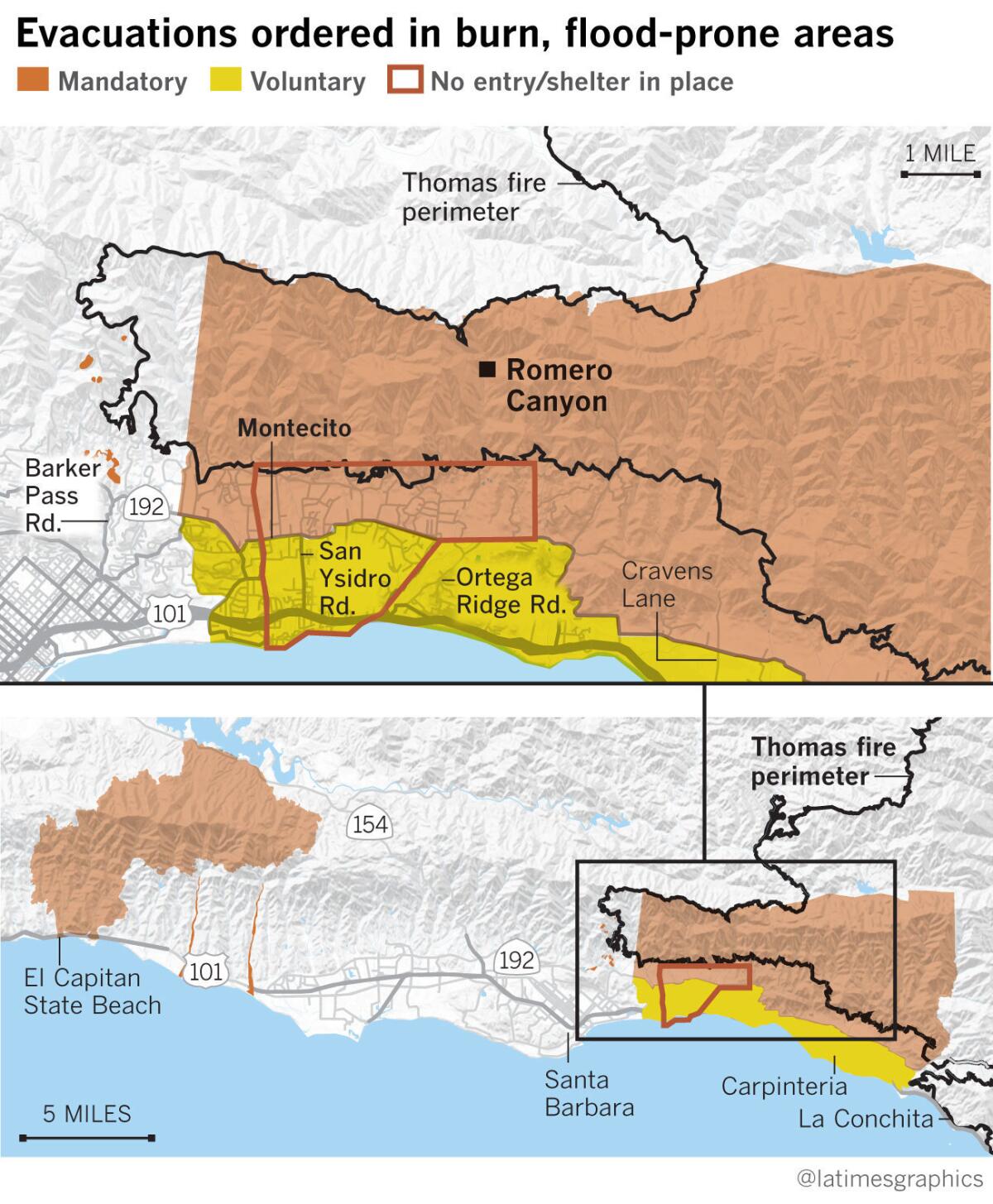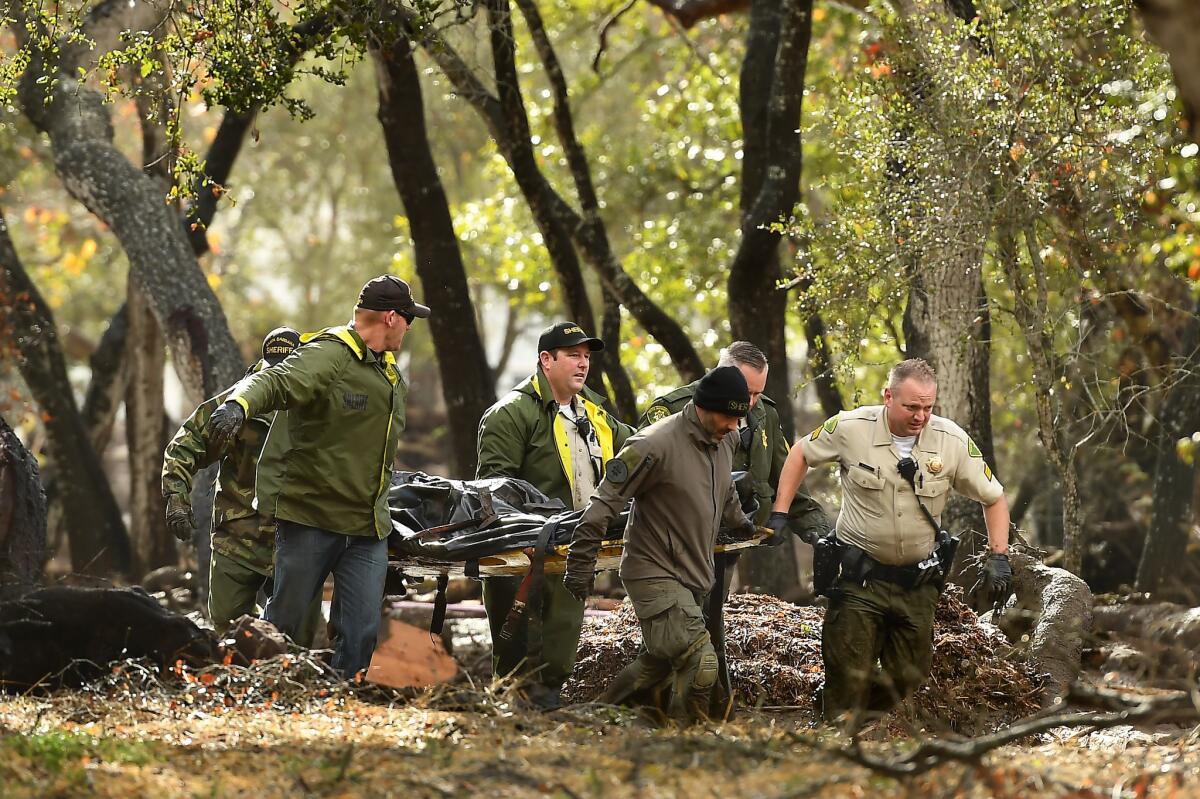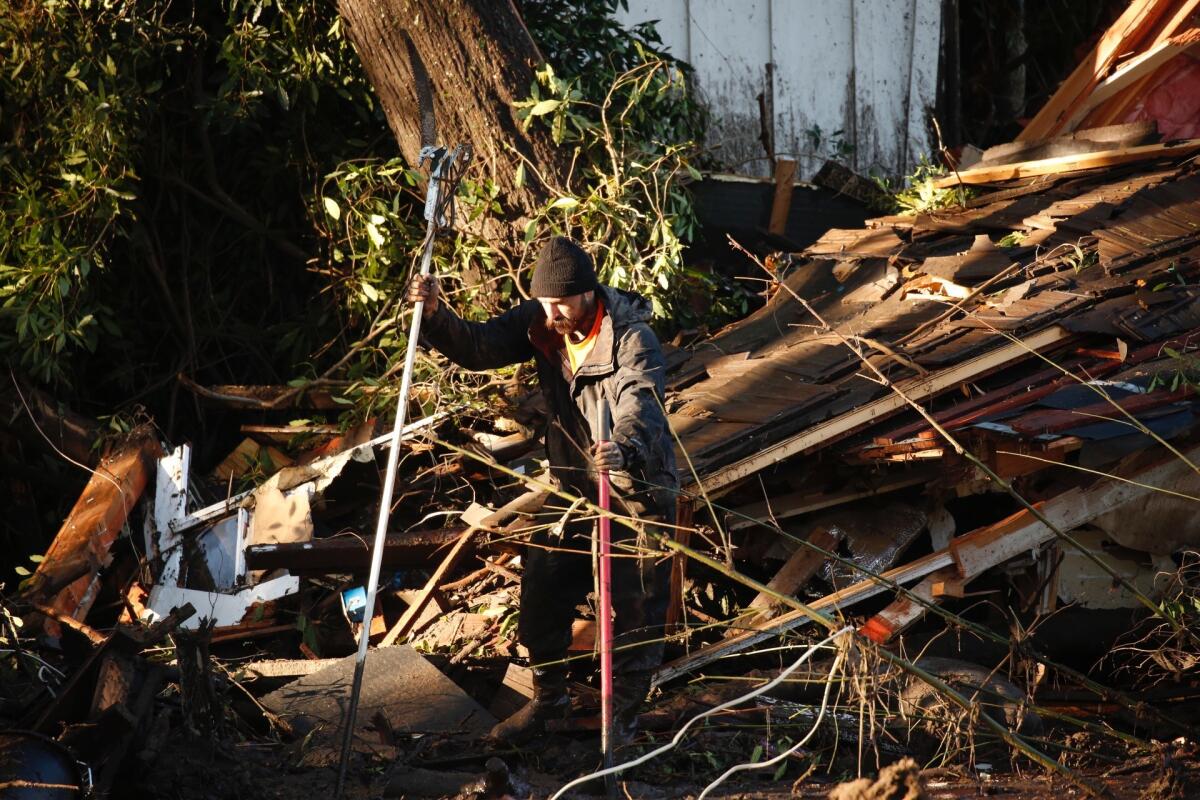Death toll rises to 17 in Montecito; 100 homes destroyed by mudslides

Devastation from mudflows in Montecito has sparked debate about what could be done to get more people out of harm’s way.
- Share via
The death toll from massive debris flows that buried homes and cars under a torrent of mud and boulders rose to 17 in Montecito, where local personnel and the U.S. Coast Guard continued rescue operations Wednesday afternoon.
About 300 people who were stuck in their homes in Montecito’s Romero Canyon neighborhood throughout the debris field were rescued Tuesday night. Authorities had said late Tuesday that residents were still stuck and that first responders planned to launch helicopter rescues at daybreak.
The mudslides began around 2:30 a.m. Tuesday, when intense rains dislodged boulders and caused heavy mudflow along hillsides that were scarred by the sprawling Thomas fire late last year. A number of homes were ripped from their foundations, with some pulled more than half a mile by water and mud before they broke apart.
“It looked like a World War I battlefield,” Santa Barbara County Sheriff Bill Brown said Tuesday.

The death toll rose to 17 after bodies were recovered Wednesday, Brown told reporters at an afternoon news conference.
At least 28 others had been reported injured, and 17 more are missing, officials said. Approximately 100 homes were destroyed and 300 were damaged in the mudslides. Eight commercial properties were also destroyed.
Officials have yet to publicly identify any of those killed in the mudslides. Mike Eliason, public information officer for the Santa Barbara County Fire Department, said there were juveniles among the deceased.
With much of the area still inaccessible, officials have said they fear the number of people killed in the mudslides could rise.
PHOTOS | Thousands evacuated as first major rainstorm in a year hits Southern California »

Southern California was drenched Tuesday, but nowhere did the rainstorm inflict more pain than in Montecito, just weeks after the coastal community dealt with the devastating Thomas fire.
Some 500 firefighters from across the state rushed to help, with crews struggling through clogged roads, waist-deep mud and downed trees throughout the day in search of victims. Dozens of survivors were hoisted to safety in helicopters.
The rain overwhelmed the south-facing slopes above Montecito, flooding the creek and sending mud and boulders into residential neighborhoods, officials said.
On Wednesday morning, the noise of construction crews using bulldozers to move boulders and fallen trees along Sycamore Canyon Road and Hot Springs road echoed down empty streets. Thick mud and downed power lines filled the streets. As the rescue crews tried to open pathways, some residents walked through the mud hoping to aid in the search for missing relatives and friends.
With a shovel in one hand, a man who asked to be identified only as Mikey smoked a cigarette and then started shoveling mud and debris from the intersection.
He had been out since 5 a.m looking for his girlfriend’s missing sisters: Morgan and Sawyer Corey. He said their house, located roughly a half mile away in Sycamore Canyon Road, had been swept away.
“They are good people,” he said with tears in his eyes. “I’m hoping to find them.”

As he waded through deep mud, Montecito resident Ben Ekler said his friend’s mother and two children were swept away during Tuesday morning’s deluge. The mother and one of the children were found and are recovering at an area hospital, he said.
But the other child is still missing.
At least 7,000 people have been evacuated from the area. As part of ongoing rescue efforts, a “public safety exclusion zone” has been established in Montecito.
Residents in areas west of Sheffield Drive, East Valley Road and Ladera Lane, east of Olive Mill and Hot Springs Road, north of the ocean, and south of the U.S. Forest Service boundary are being asked to shelter in place and not move around the area. The move is designed to ease the task faced by rescue personnel, and those spotted in the area without approval could face arrest, authorities said.
Helicopters and rescue workers from the U.S. Coast Guard and National Guard, as well as firefighters and helicopters from fire departments in Los Angeles, Orange and Ventura counties have all descended on Montecito, Eliason said.
An airship with night-vision capabilities hovered over the damaged area through the early morning hours. With the rain stopped, Eliason said rescue crews remain hopeful they can soon reach others who are trapped.
“The weather was favorable. Search and rescue is still very confident that we’re still in that window for rescue mode,” he said. “We’re actively pursuing trying to get in there as quick as we can to get those people to safety.”
Deadly flooding on Santa Barbara coast as fire turns to mud »
Rescuing those trapped in Romero Canyon and reaching other homes that were made inaccessible by the mudslides was a priority, he said, because many of those people could be without crucial supplies.
“A majority of Montecito and that whole area is in the Stone Age right now,” Eliason said. “There is no water. There is no gas. There is no electricity.”
The storm system that hit Southern California beginning Monday dumped more than 5 inches of rain on some parts of Santa Barbara and Ventura counties, and officials had been concerned that sections of the state damaged by last month’s wildfires would be susceptible to heavy mudflows. Soil scorched by fire is less able to absorb water.
Mudflows washed out a nearly 30-mile stretch of the 101 Freeway between Santa Barbara and Ventura, and also prompted evacuations in parts of Burbank and Los Angeles on Tuesday. The heavy weather also caused a surge in motor vehicle accidents across the Southland, according to the California Highway Patrol.
But Santa Barbara County clearly took the brunt of the damage, where mud, boulders, husks of cars and housing frames were common sights. The section of Montecito that was hit hardest was actually south of the Thomas fire’s burn scar, and not subject to mandatory evacuation, according to Eliason.
But a creek that feeds the Pacific Ocean swelled early Tuesday morning, raining boulders and flood waters onto residents as they slept.
The rains were like a starter’s gun for many in Montecito and nearby Carpinteria. Peter Lapidus said the sound of droplets pummeling his home forced him out of bed around 4 a.m. Tuesday.
“It was like a bomb went off,” he said. “It wasn’t raining hard, and then it was like you flipped a switch.”
Maude Feil, who was traversing the mud on Olive Mill Road with a walking stick Wednesday morning, said the area looked “like an apocalypse happened” when she first emerged from her home the day before.
As she walked, she made a grim discovery when she spotted what she thought was a mannequin beneath railroad tricks
“It was a woman’s body,” she said.
Feil had to evacuate during the Thomas fire, and said she was worried survivors who managed to get through the wildfire unscathed may have lost everything they own in Tuesday’s debris flow
“I’ve never been so close to a fire in my whole entire life, then this,” she said. “People who didn’t lose their house in the fire — they just lost huge things in the mud. It’s like a war zone or something.”
Etehad and Mejia reported from Montecito. Queally reported from Los Angeles. Times Staff Writers Joseph Serna, Alene Tchhekmedyian and Hailey Branson-Potts contributed to this report.
Follow @JamesQueallyLAT @brittny_mejia & @melissaetehad for breaking news in California.
UPDATES:
4:50 p.m.: This post was updated with an updated figure on people reported missing.
4:25 p.m.: This post was updated with a new death toll and information about those rescued from Romero Canyon.
1:30 p.m.: This post was updated with additional information about the number of people injured and the number of buildings that were damaged or destroyed in the mudslide.
9:10 a.m.: This post was updated with comments from Montecito residents searching for missing relatives and friends.
8:30 a.m.: This post was updated with the number of people missing and injured and additional details about rescue efforts.
7:55 a.m.: This post was updated with details on the public safety exclusion zone.
This article was originally published at 6:55 a.m.
Sign up for Essential California
The most important California stories and recommendations in your inbox every morning.
You may occasionally receive promotional content from the Los Angeles Times.










